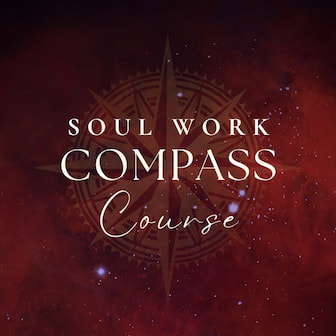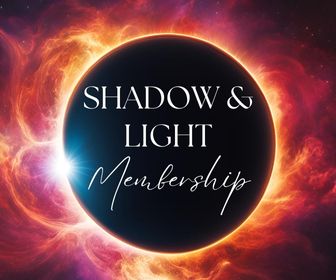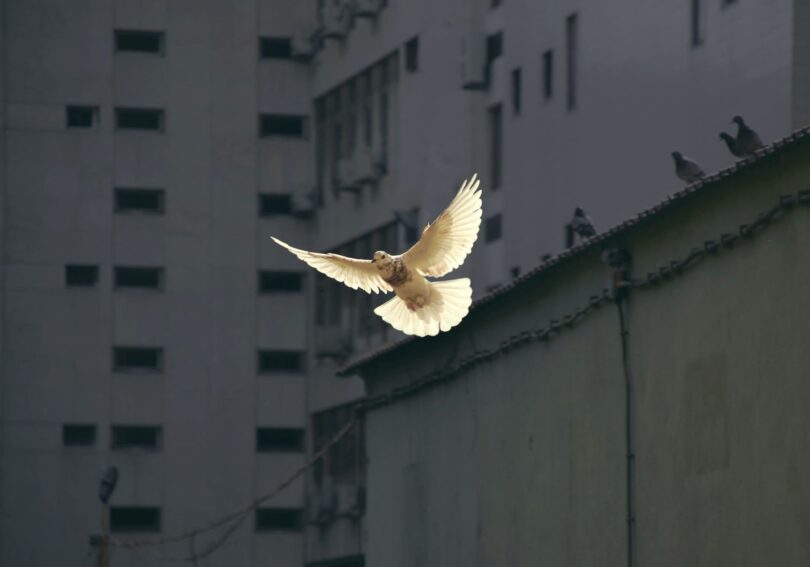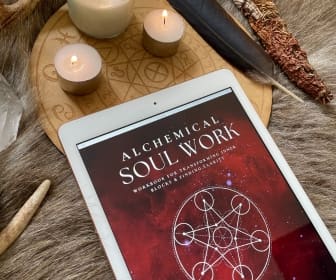Let’s be honest here, being present in the moment sounds good in theory … but in practice, we suck at it 99.9% of the time.
How many times have you found yourself making all these fancy mental plans of “being as present as you possibly can” and imagining yourself as a Zen-master-to-be or advanced yogi in the making … and then a few minutes later you’re crunching down a packet of Doritos and staring vacantly at the Instagram stream on your phone?
Can you relate to this frustrating phenomenon?

Soul Work Compass Course:
Feeling lost, stuck, and trapped in repetitive cycles of pain? Discover your Soul's Compass to reclaim your purpose and find your path to freedom.
⭐️⭐️⭐️⭐️⭐️ "I am finding out so much about myself and having so many realisations about my life ... I already know it is what I’ve needed for so long." – Jen N.
Since interest in meditation and mindfulness blossomed in the 1990s there has been endless talk about the importance of “being in the present moment,” practicing mindfulness diligently, and meditating every day.
It seems like everywhere we look in the realm of wellness, self-help, and spirituality, being present is glorified as the highest of virtues. And I have nothing against that because it’s true. Being present is really the only sane way to live life.
But there’s one sticky issue that I’ll cover in this article, along with some down-to-earth advice for how to be more present each day.
Table of contents
What Does ‘Being Present’ Mean?

Being present simply means inhabiting this moment without getting lost in thoughts about the past or the future. When we’re being present, we’re vividly awake and conscious of what is going on in the here-now.
A definition of being present often used is quoted from professor and founder of Mindfulness-Based Stress Reduction, Jon Kabat Zinn, who defines the present moment (or mindfulness) as:
… paying attention, on purpose, in the present moment, non-judgementally.
The Power of Presence: Why it’s the Solution to Nearly Everything

With popular books like ‘Be Here Now’ by guru Ram Dass published in the 1970s and ‘The Power of Now’ published in the 2000s by spiritual teacher Eckhart Tolle, most of us on the spiritual path are aware of the power of being present.
We can recognize that when we’re fully living in the here and now, we’re not suffering as much from the baggage of the past or future anxieties.

Shadow & Light Membership:
⭐️⭐️⭐️⭐️⭐ "traight from the very first weekly email, this has been mind-blowingly powerful, the synchronicity and the on-vibe contents resonate uncannily with my soul’s current challenges."– Marie
Being present helps us to tend to our needs, be more thoughtful and empathetic with others, make wiser and more conscious choices, listen to our Soul’s deeper impulses, slow down and appreciate life, and experience states of joy, awe, and peace.
Furthermore, when we’re present and are truly ensouled in the here-now, we’re also less identified with the fragmented and contracted sense of self that we call “ego.”
The ego or sense of “me” – which is essentially just a conditioned habit of thought that is changeable, permeable, and ultimately illusory – dissolves when we’re in the present.
The result of this temporary ego dissolution is a feeling of more freedom, social connectedness, and even spiritual Oneness.
All in all, being present is powerful because it is the only place or space in which we can feel truly alive, at peace, and whole.
But there’s one major pitfall most of us tend to make when we’re trying to be “more in the present moment.” We’ll explore that next.
Why is Being in the “Present Moment” So Damn Hard?
I actually made a video about this question a while ago, so if you feel like watching my explanation (shared alongside Mateo), you can watch it below. Otherwise, keep reading!
At one point or another, most of us have felt frustrated about and disappointed by our inability to “stay in the present moment.” We’re prone to wondering things like, “Why can’t I just be more present? Why is it so damn hard? What’s wrong with me?”
At the very worst, the whole idea of trying to be “more in the present moment” is a yardstick by which the spiritual narcissist within us uses to measure our worth and “spiritualness.”
In other words, that part of the ego that masquerades as “being a spiritual person” (aka. what I’m referring to as the spiritual ego here) will ultimately find the practice of being present in the moment not just a threat to its “level of spiritualness,” but also fundamentally a stressful chore and finally, a tortuously difficult activity.
But why?
Would you like to save this?
Your information will never be shared.
To put it simply, we find it so difficult to be in the present moment because the very words – the very notion of a “moment to be in” – is totally misleading.
The Merriam-Webster Dictionary defines “moment” as “a minute portion or point of time; a comparatively brief period of time” which makes it sound like being present can only happen in a tiny little spec of the here-and-now.
“Present moment” gives our minds the impression that being present means somehow “catching” that little sliver of time that’s here, because the next moment it’ll be gone. If we don’t latch onto that tiny spec of time, our opportunity to be mindful is over!
Take a moment (there’s that word again!) to consider what “present moment” means to you … go on. Look away for a few moments from the screen and connect with what “present moment” means to you …
Does it seem like the “present moment” is a brief and passing period of time?
If so, I want to point something out here:
There’s no such thing as a “present moment” because the only moment there ever is, is this, here, now.
Even thoughts of the past or future, or getting lost in daydreams, or anything else your mind conjures, only ever happens in the this-here-now. When else could it happen? Really?
Perhaps a better and more accurate word would be present movement. Whatever is happening in the this-here-now is dynamic, alive, fresh, spontaneous, and always forever changing.
I take inspiration for this term from spiritual writer and teacher Jeff Foster, who writes:
Since the words ‘moment’ and ‘movement’ come from the same root, it may be better to call this the present movement. The present movement of life! The movement of thoughts, sensations, feelings.
There is a kind of alive effervescence to the term “present movement” as opposed to the more static and dry “present moment.”
I have personally found that connecting with the present movement is a far more enjoyable, sustainable, and realistic practice than trying to catch the next present “moment.”
Going Deeper: You ARE the Present Movement

The second part of what I’ve just written about above is that the here-now is not only an ever-changing movement, but it’s also what you are at your core.
Let me explain a little more.
The second part of why we find being present so difficult is that the separation between “I” and “the now” creates a friction that makes it seem as though you have to “get to” or “find” or “catch” the present movement – and that can keep you stuck in a never-ending mental hamster wheel of trying to “be in” the here-and-now, which paradoxically evades you. (And yet, even this search for the ever-present now always happens in the now!)
But as teacher and author Scott Kiloby writes,
In enlightenment teachings, you may hear the phrase, “be present.” But if you look around, ‘you’ are the present moment. ‘You’ are not separate from it. ‘You’ are life itself. The only thing obscuring this realization is mental and emotional activity that continuously tries to move away from this moment into a dream of past, future, and resistance to now. The notion that you are separate from life is a creation of thought.
In other words, deeper than the semantics of “present moment” vs. “present movement” is this fundamental sense of separation we feel that arises from the sense of self, the ego.
For over a decade, we've strived to make this website a haven of free, valuable information. Imagine a world where this knowledge wasn't readily available. If this post sparked a meaningful insight or helped you in any way, please consider a donation as a heartfelt "thank you" for keeping this resource free. Every contribution, big or small, allows us to keep giving back.
The ego is a necessary biological survival mechanism, and I’m not saying to go and “kill your ego.” But if you can see that trying to “be in the present” from the stance of the ego actually blocks your capacity to recognize that you are Life itself – which is by nature always here-now – then you’ll see why it can feel so difficult to practice being present.
As Kiloby goes on to write,
Paradise is already here, now. It has always been right here, right now under the dream that there was a “you” who was somehow separate from it and who needed to do something to find it.
This notion of paradise or freedom that comes through recognizing ourselves as the present movement of Life itself, reminds me of an old biblical quote from Jesus in which he says,
Neither shall they say, Lo here! or, lo there! for, behold, the kingdom of God is within you.
If you’re confused or unclear about anything written in this section, I encourage you to explore the nature of your sense of self.
Exploring the field of non-duality and practicing the “Who am I” self-inquiry meditation can help tremendously.
Blocks to Being Present

Let each of us examine his thoughts; he will find them wholly concerned with the past or the future. We almost never think of the present, and if we do think of it, it is only to see what light is throws on our plans for the future. The present is never our end. The past and the present are our means, the future alone our end. Thus we never actually live, but hope to live, and since we are always planning how to be happy, it is inevitable that we should never be so.
– Blaise Pascal
Now that we’ve explored the two biggest blocks to being present (the misleading idea of a “present moment” and the divisive nature of the ego), let’s explore a few other blocks.
There are many reasons why the mind wants to avoid being present. Here are some common blocks:
- Avoiding the present movement due to unresolved emotional or physical pain that makes being in the now painful
- The belief that happiness/fulfillment was in the past or is in the future
- Contracted energy in the body/nervous system that fuels thought, creating a cycle of body-mind escapism from the here-now
- Beliefs about how life “should be” and therefore a rejection of the present movement as being “too simple and too boring”
- A dense shadow self that creates addictive and escapist behavior
- Fear of the inevitable ego death (scary word for something actually quite beautiful) that comes from being truly present
The above list isn’t exhaustive, but you get the picture. And the reality is, all of these blocks happen in the present movement anyway, even if we aren’t aware or consciously tuned into it!
5 Practices For Being Present

It’s kind of ironic that I’m suggesting practices here for “being present,” when you are always and forever in the present and you don’t really need to “do” anything to “get there.”
And yet, life is a great paradox. From the perspective of the ego, which most of us operate from, we need something to do, something to orient ourselves with.
I’m not going to proclaim that there’s “nothing to do” and “nowhere to go” even though that’s technically true on an objective level. Why? I like to honor the objective and subjective. And subjectively, the mind needs something to chew on.
So let me throw it a bone and recommend some practices for being present:
1. Find a source of flow
The “flow state” was a term first popularized by psychologist Mihaly Csikszentmihalyi in the 1990s and describes the experience of getting so immersed in something you love that all sense of time vanishes. You’re completely in the flow and in the now.
Finding a source of flow allows you to be totally immersed in the present moment in a joyful way. The best way to find your source of flow is to discover what you love doing and what you’re passionate about.
For some people, flow comes through creating art or cooking, for others, it comes through playing sports, fixing motorcycles, or going on a hike. Ask yourself, “What do I love doing?” and notice the present movement as you’re immersed in that activity.
2. Observe babies and animals
Babies and animals are always in the present movement, in the here-and-now. Take some time to learn from them. Watch their spontaneity, their openness, their freshness.
I have two dogs in my life right now: Lila (an insanely playful Labradoodle) and Forest (a Dr. Jekyl and Mr. Hyde Shihpoo) and they are an endless source of silly, joyous, and surprisingly wise insight.
What can the innocence of children and animals teach you about being present?
3. Find the magic of solitude in nature
Nature has taught me so much about moving with the seasons, that we need to honor times of harvest and times of rest. That the frenetic pace of doing, doing, doing, without being present with each other and the season we are in, what is happening around us, is unnatural and counter to life.
– Brenda Salgado
Nature is the biggest never-ending source of dynamic movement. The movement of the wind, trees, birds, wild animals, sunshine, clouds – all of it is a magical doorway into the now.
Be assured that if you take some time to sit in nature and observe it, you’ll likely feel on a deep level what being present is all about.
I recommend solitude in nature specifically because it helps you to step out of your mind (which comes when you’re chatting with other humans) and into the flow of what is happening here-now.
4. Open awareness meditation
There are two main types of meditation (that branch off into numerous other styles of meditation): focused and open meditation.
You’re probably familiar with the “focus on your breath” style of meditation which is taught everywhere. But there’s also a slightly lesser-known form of meditation, which is open-ended and unstructured.
To practice open awareness meditation, dedicate twenty minutes or more to sitting somewhere undisturbed and simply watching whatever comes into your field of awareness. Don’t try to control, change, or focus in particular on anything. Just let it all come and go.
Thoughts, feelings, sounds, bodily sensations, colors, vibrations, memories, smells, and literally anything/everything will likely pop into your awareness. Simply watch how it dances and changes, and notice what it’s like to be present in this state.
You might even like to try out this guided open awareness meditation from Rupert Spira (which will help you out):
5. Use the mantra “so hum”
Chanting mantras is a sacred spiritual practice that has been used for thousands of years to calm and center the mind.
Above I described the process of open awareness meditation – here, by using a mantra, we’re adopting a more focused form of meditation. But this focus doesn’t have to be rigid or constricted. The purpose of mantras is to focus but also open your awareness.
Why do I recommend the “So Hum” mantra in particular? Firstly, this mantra is easy to remember and practically anyone can easily recall it during the day.
Secondly, “So Hum” can be used easily along with the breath. “So” mimics the in-breath, and “Hum” mimics the out-breath. You can even draw them out to make this mantra extra engaging as in “soooooooo” (breath in) “huuuuuummmmmmm” (breath out).

Overwhelmed by where to begin?
The Alchemical Soul Work Workbook is your map and compass. It takes the guesswork out of deep inner work, empowering you with a step-by-step process to confidently find clarity and alignment with your true Self.
Thirdly, So Hum is a Sanskrit word that translates to “I am that” which beautifully mirrors what I wrote previously in this article: that beneath the ego, we are Life itself appearing as this present movement. In other words, “I am that” (“So Hum”).
The So Hum mantra can be used throughout your day either silently in your mind, in a whispered breath, or out loud (depending on the situation). This is a mantra that can give your mind something to gnaw on while simultaneously quietening down your inner landscape enough to recognize the present movement of what is happening, right here, right now.
I like to use this mantra in a spontaneous sing-song way so that it doesn’t become monotonous. Be creative and know that you don’t need to confine your mantra to a dull drone or a compartmentalized practice that you do for only part of the day. Live and breathe it!
And as you’re saying the mantra, notice whatever is happening right now – that could be seeing a pile of dog shit on the sidewalk, listening to a car zooming by, feeling pain in your arms, hearing a bird chirping, feeling your heart thumping … or literally anything!
Final Words

Being present doesn’t need to be a chore, something we “arrive to,” a virtue we cultivate, a special place we’re granted special access to, or anything of the like.
Being present is always available.
It cannot be found over there, or in thought, or in a special spiritual formula, or in an idealistic dream of a perfect spiritual seeker – that present movement of energy is here, right now. It’s even appearing as the thoughts, contractions, false identifications, mental stories, and beliefs about having to “catch” the present “moment.”
When we shift away from seeing the here-now as a tiny slice of time that we need to fight to hold onto and recognize that the here-now is actually a dynamic, ever-changing, vivacious aliveness, being present become more fun!
We begin to see that the here-now isn’t a present “moment” but a present movement, and that deeper than the ego, we are that chi, that life force energy, kundalini, prana, Spirit – whatever you want to call it – that appears as all things.
What is your experience and relationship with being present? I’d love to hear any epiphanies or adventures you’ve been on surrounding this topic.
Also, please feel free to share this article with someone if you feel they might enjoy reading it!
If you need more help, we offer 2 powerful ways to guide you on your inner journey:
1. The Soul Work Compass Course: Break free from feeling lost and disconnected. The Soul Work Compass is a practical 12-step course that transforms soul loss into soul clarity. Discover your core values, heal core wounds, and create a personalized compass to guide every decision you make.
2. The Inner Work Journal Bundle: Heal at the root. This Inner Work Journal Bundle guides you through self-love, inner child healing, and shadow integration with 150+ prompts and activities. You get editable digital files to use on any device or print unlimited times. Not for lukewarm seekers, these journals are for those ready to transform.



 $3
$3




Thanks for the clarifications, chasing a second is never presence, it is striving.
Personally, while being present, I notice funny things about the mind.
Spontaneous thoughts keep showing up.
My mind keeps telling paradoxal or irrelevant things.
My mind:”You must care about appearences, people are laughing at you!”
And the next second, the same mind says:
“You fool! Don’t care about appearences, you are not born for people!”
And surprisingly, its the same mind that says:
“The mind is evil! Stop it and kill the ego!”
And so, it only goes into loops, with many much more complex mind-situations. Unless it is used controllably to survive and to solve things in daily life.
So in brief, the mind-process should not be taken seriously.
Ahh yes, so true Haytam! When you really tune into what the mind says, it’s often a load of the strangest dialogue you’d ever hear (like that of a crazy person). The other day for example, I heard my dogs barking, and the ‘Catastrophic Karen’ (the name I gave that part) in my mind was SO sure someone was breaking in and was going to murder my dogs in broad daylight – and this is just the tip of the iceberg! Thanks for sharing these amusing reflections. :)
Excellent!
Very practical and succinct.
Thanks Jim :)
Tank you, thank you soo much♥️! As I wonder and ponder upon life , what’s the meaning and trying to find peace and action at the same time- this article really summed it up for me. Present movement!! Here I go!! With Love!!
Lots of love Bridget ♡
Thank you for this insight and explaining things so clearly! I’ve been listening to Eckhart Tolle talking about presence and have noticed how much my mind makes up stories about what is currently happening and relating it to past experiences or creating fear about the future. Just noticing that has made a difference and I’m somehow able to step away from the chatter. I love to drive and find its a really good time to practice being in the flow state, to meditate and notice when I’m completely distracted! I notice how much I’m always in a hurry or judging what others are doing on the road. The other place I’ve discovered this is at the supermarket, especially going through the self checkout. I actually find it hilarious now noticing how much my mind gets involved in the process. It’s a relief to know that spiritual practices don’t need to be about lofty ideals but the simplicity of mundane everyday tasks.
“It’s a relief to know that spiritual practices don’t need to be about lofty ideals but the simplicity of mundane everyday tasks.” – oh yes! Actually, these lofty ideals are just thoughts created in the mind anyway – they can orient us, but they can also delude us into constantly chasing and seeking what is already and always here (consciousness, beingness, underneath and prior to the sense of “me”). The joy can be found in this simplicity: in the fingers touching the phone screen or keyboard, in the sound of the cars outside, the pressure in the stomach, the burp from another family member, the dog barking, the sun shining, etc. Spiritual ideas and concepts can be very useful and helpful, but at the end of the day, what’s real is this, right here, right now. Thank you for sharing your process of flow Fiona!
Tapping all your senses, sight, sound, smell and touch. Smell the air, especially when no geoengeneered jet clouds are present. Notice how much better your breathing in that untainted natural fresh air. Nature and especially water almost always find me in the present movement along side it. An appreciation helps me also. Soak in it.
Thanks Mike :)
thank you both of you! I couldn’t agree more. I agree with Scott, we are life, we are the present movement. We are not a static thing. This is all a wonderful adventure. I love the experience of not knowing, enjoying the mystery and being open to be aware of anything or nothing. Much Love, Stephan
Beautiful and agreed ♡
In a healthy sense and just before meditation I find Qi Gong exercises very beneficial in stilling the Ego mental activity as you focus more on your movements and the flow of energy as it moves around the body. Plus it is a great gentle way for us oldies to get some exercise from old people’s knots and energy blocks. Other forms of flow as you say are just sitting very still and slowing the breath right down to a quiet rhythm and waiting for the ego mind with all it’s imaginative imagery to follow. This I call letting go and allowing the dust to settle.
Trance work via self hypnosis too can use sounds or soft music and spoken words to drop the mind down a comfortable secure pathway into the inner realms of the subconscious which can be both cleansing and relaxing at the same time. Which leaves you feeling all warm fuzzy and relaxed yet clearly aware of the present moment awareness and able to function at a quieter level. Another form of this trance state is when you get some chores done and then flop down into a comfy chair to relax and find your mind shifts from the activities to just staring out of the window at beauty and flow of nature.
As an artist I find pencil drawing for any length of time can tune out the outer thoughts of the world and turns the mind into a quiet flow where any art problem just flows in harmony and almost creates itself. So the 90% hard focus concentration and accurate rendering gives way to complete relaxed clarity and easy form and function. Or artistic bliss! Also found with painting pictures as your thoughts chill out and other parts of the aware mind seem to tell you where and how the next dob or brush stroke needs placement
Similar to say having a couple of beers on warm afternoon and just watching blissfully as the trees outside gently flicker and flow with the breeze. More Bliss!
Nice, I like these suggestions! Do you have any recommendations for specific Qi Gong exercises John, for anyone who may be reading this? I’ve tried Qi Gong before but got overwhelmed by it. Any suggestions would help. :)
Being “present” is simple – it’s the BREATH. One can’t focus on the mind (thoughts of either past or future) and focus on the breath, at the same time, ie those two things can’t operate in the SAME SPACE at the same time. It’s impossible. It’s either one or the other. So we’re either in “the present moment”, or we’re in our heads. “Breath” is the closest thing to us, our best friend, our energy source & the ONLY thing that is “constant” & doesn’t change, (until we die). Yet we walk this earth not realizing or being aware of our breath most of the time. “Breath” IS the answer to being in the “present moment”.
Thank you for this insight Chris. :) What I love is that the breath breathes itself when you really pay attention – and yet, it can also ‘seemingly’ be controlled at will as well. Amazing!
My problem with being aware in/of the present moment is in contrast to what you said in suggestion #1. I get so involved in a job of work I’m doing on the computer, or a game I’m playing, or a book I’m reading, that I lose all awareness of everything else. I couldn’t tell you if the sun was shining or my ankle aches. All my concentration is focussed on what I’m doing rather than how I’m being. I’m sorry you didn’t address this problem.
Finding a source of flow needs to be accompanied by intentionality, aka. rather than getting lost in it, it can be something we become super present through. I’m not sure if that makes sense, but try and incorporate some of the other suggestions, and that will probably help Kathy. ;)
Hello Aletheia,
I’ve been a reader of yours for many years, but never before now left a comment, just lurked in the shadows! But for whatever reason, perhaps because this article is about the here and now itself, I feel compelled to step out of the shadows and take this moment (or movement!) to express pure and infinite gratitude to you for sharing your amazing insight with the world. Loner Wolf has helped me many times throughout the last few years as I’ve undergone my own spiritual journey. It began with a spiritual experience in Glastonbury and only got weirder from there. I took up yoga among other things and your articles on chakras–by far the most detailed, specific, and cogent I’ve ever encountered online–helped me in so many ways, particularly healing from my own traumas. Recently, I’ve discovered, and am trying to practice, non-dualism; I’ve been loving all of your insight into this topic and you helped contextualise much of the confusing information I gleaned from other sources. This article came at exactly the right moment, where I’ve been struggling.
I think your suggestion to shift the linguistics from “moment” to “movement” is ingenious and so helpful. It chimes beautifully with yogic ideas, for each posture is a movement that flows into the next and, even when held for extended periods of time, contains subtle movement and energy-movement within it.
I am certainly guilty of forever chasing a “moment” that, by very definition, is already past. When I enter deep meditative states and the ego finally lets go I perceive reality as a river of music. Rivers of course are constantly in motion, and this is revealing I think because it perhaps more accurately reflects the ultimately indescribable reality, Life, universe, phenomenon of existence we inhabit. Your work is helping us all navigate this river!
Side note: I love how you also say that the subjective has its place, and should be acknowledged. It’s easy to lose one’s grounding when all of this begins to open up. I know I am guilty of the “head in the clouds” syndrome!
I wanted to say two other things (forgive the essay): firstly, I wanted to ask for your further insight on this point “Contracted energy in the body/nervous system that fuels thought, creating a cycle of body-mind escapism from the here-now” — if it’s not too much trouble. When you say “contracted energy”, do you mean energy that has been stymied from flowing out in some way? I am also intrigued by the correlation with escapism. I’m a fantasy author, as it happens, so escapism has been part of my business and great pleasures in life (although arguably there is no such thing as “fantasy”, for my life has featured many events far too strange to put into print. As G. K. Chesterton observed: “The difference between fiction and reality is that fiction has to be credible!”) But I do also recognise escapism’s harm, especially when one is seeking pleasure in an attempt to elude pain. I’m interested to know more about the cycle. Any of your insights welcome!
Secondly, on the topic of me being an author, I would love–with your permission–to quote from some of your articles, fully credited to you and your site, in my upcoming writing craft book THE DIVINE. Should be out August of this year. Very much an esoteric approach to creativity. I got a little tired of all the very materialistic books out there (How To Make Money Writing, etc) and wanted to write something for the weirdos like me who still believe in Muses and the inner, living God, haha. Please let me know if you’d be willing to be quoted. Like I said, links will redirect to you and you’ll be fully credited. I won’t be offended either way, however. All will be as it should be.
Lastly, I’ve left a donation. Not much, but I hope it helps just a little to keep this site going. This is an invaluable resource for any Seeker.
Thanks for letting your light shine!
-Joe
Hi Joseph,
Thanks for taking this present movement to say hi. And I really appreciate your donation, thank you! :)
Answering your questions:
“Contracted energy in the body/nervous system that fuels thought, creating a cycle of body-mind escapism from the here-now” – what I mean by this is that the body impacts the mind, and vice versa. When there is contracted/constricted/blocked energy in the body, it tends to add density to our thoughts, making them seem more important/real/valid than what they actually are. For instance, if I carry tension in my neck, I’ll most likely start feeling that “others are a pain in the neck” (to use the common expression from which this idea is essentially derived!). I hope that makes sense? So yes, stymied energy.
Regarding quoting this article, you’re more than welcome (with credits, etc.)!
With love and gratitude ♡
Thank so much for answering, Aletheia. Your response reminds me of the work of Louise Hay, whose theory about the correlation between mind and body seriously helped me in relation to my health. It is great when experts agree! Haha. Thank you again.
Thanks Joseph ♡